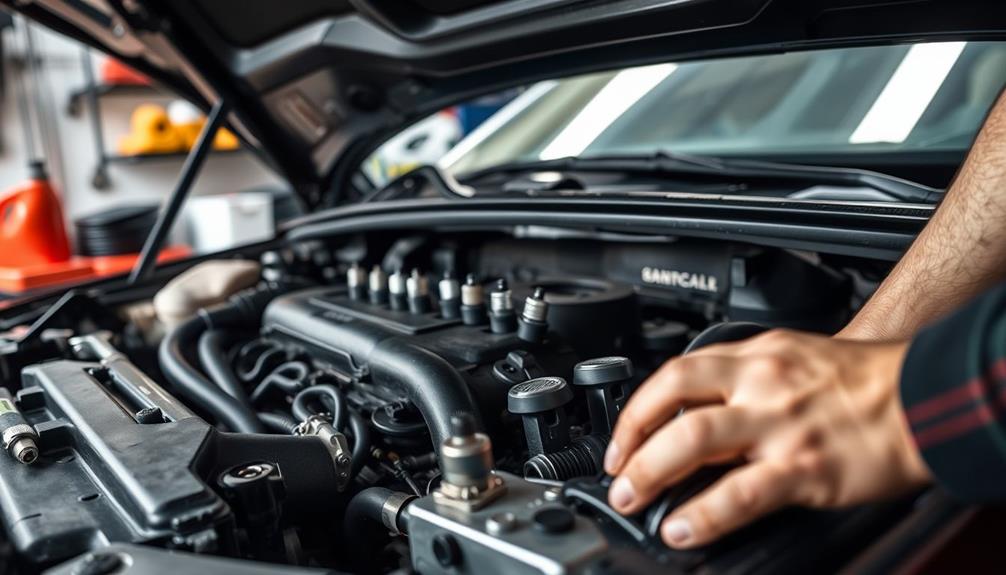To master OBD‑II scanning and decode trouble codes at home, connect an OBD‑II scanner to your vehicle’s port and access the codes. You’ll learn what specific issues your vehicle reports, allowing you to diagnose problems quickly and accurately. Many tools also show live data and freeze frame snapshots to help interpret sensor performance. Keep practicing, and you’ll gain confidence in identifying and addressing vehicle troubles effectively. If you keep exploring, you’ll uncover even more diagnostic tricks.
Key Takeaways
- Use an OBD‑II scanner to quickly connect to your vehicle and access trouble codes without professional help.
- Learn to interpret trouble codes using the scanner’s database or online resources for accurate diagnosis.
- Analyze live data streams to monitor sensor performance and identify potential issues in real time.
- Review freeze frame data to understand the specific conditions when faults occurred.
- Clear trouble codes after repairs and verify resolution by re-scanning your vehicle at home.

If you’re looking to diagnose your vehicle’s issues quickly and accurately, mastering OBD‑II scanning is essential. The key to doing this effectively lies in understanding how to use diagnostic tools and interpret the trouble codes they provide. These tools are designed to connect directly to your vehicle’s OBD‑II port, enabling you to access the onboard computer’s data and pinpoint problems without needing a mechanic’s assistance. With the right diagnostic tools, you can read and clear trouble codes, giving you immediate insight into what’s causing issues like engine misfires, emissions failures, or sensor malfunctions. Developing digital literacy skills can further enhance your ability to navigate and utilize these diagnostic resources effectively. Code interpretation is the fundamental skill you’ll develop when mastering OBD‑II scanning. When you connect your scanner, it retrieves specific trouble codes—alphanumeric sequences that correspond to particular problems. These codes serve as your first clue, guiding you toward the component or system needing attention. Learning how to interpret these codes allows you to understand the nature of the issues without guesswork. Instead of relying solely on vague symptoms or trial-and-error, you can use the code descriptions provided by your diagnostic tool or an online database to target repairs precisely. This not only saves you time but also reduces unnecessary parts replacements and labor costs. Using diagnostic tools becomes more intuitive as you familiarize yourself with the code meanings. Many scanners display live data streams, so you can monitor how sensors and systems are functioning in real time. This capability helps you verify whether particular components are operating within normal parameters or if they’re causing trouble. When you learn to interpret this data alongside trouble codes, you gain a thorough understanding of your vehicle’s health. This empowers you to decide whether a simple fix, like tightening a loose gas cap, or a more involved repair is necessary. Furthermore, modern diagnostic tools often come with features like freeze frame data, which captures the exact conditions when a fault occurs, and the ability to reset codes after repairs. Understanding how to use these features enhances your ability to troubleshoot effectively at home. In essence, mastering OBD‑II scanning transforms you from a layperson into a capable diagnostician, saving you both money and frustration. With practice, interpreting codes and understanding diagnostic data becomes second nature, giving you confidence in maintaining your vehicle and addressing issues promptly before they escalate.
Frequently Asked Questions
Can I Clear Trouble Codes Without Fixing the Underlying Issue?
You might think you can clear trouble codes without fixing the underlying issue, but that’s a DIY diagnostics myth. Clearing codes simply resets the warning lights, not the problem itself. If you ignore the root cause, the codes will likely return. It’s best to diagnose and repair the issue before clearing codes, ensuring your vehicle runs properly and prevents future problems. Don’t rely on code clearing myths; address the real issue first.
How Often Should I Scan My Vehicle for Trouble Codes?
Did you know that 30% of vehicle breakdowns could be prevented with regular diagnostics? You should scan your vehicle every few months or whenever the check engine light comes on. Using diagnostic tools helps with proactive vehicle maintenance, catching issues early before they turn costly. Regular scans keep your engine running smoothly, ensuring safety and saving money in the long run. Don’t wait—make scanning a routine part of your vehicle care.
Are There Risks in Interpreting Codes Without Professional Help?
Interpreting codes yourself carries DIY risks, especially if you’re unfamiliar with vehicle systems. Without professional help, you might fall into misdiagnosis pitfalls, leading to unnecessary repairs or ignoring serious issues. While decoding trouble codes is useful, it’s essential to understand their implications correctly. If you’re unsure, consulting a mechanic can save you time and money, and prevent potential damage from misinterpreting the diagnostic information.
What Are the Most Common OBD-II Codes and Their Meanings?
Think of your car’s OBD-II system as a doctor’s toolkit—full of sensors diagnostics and code interpretation tools. The most common codes include P0171 for a lean fuel mixture, P0300 for random misfires, and P0420 indicating catalytic converter issues. Recognizing these helps you troubleshoot effectively at home, but always verify with professional help to avoid misdiagnosis. Understanding these codes keeps your vehicle running smoothly and saves you time and money.
Can OBD-II Scanners Detect Upcoming Problems Before Symptoms Appear?
You might wonder if OBD-II scanners can predict issues before symptoms show up. They do this through predictive diagnostics by monitoring sensor calibration and detecting subtle changes in vehicle systems. While they can’t foresee every problem, they can alert you early to potential issues, allowing you to address them proactively. This helps prevent breakdowns and keeps your vehicle running smoothly, saving you time and money in the long run.
Conclusion
Mastering OBD-II scanning empowers you to decode trouble codes, understand your vehicle better, and save money on repairs. It puts you in control, boosts your confidence, and enhances your car knowledge. By learning to interpret codes, you gain insight, take action, and prevent future issues. So, embrace the tools, stay curious, and keep your vehicle running smoothly—because the more you know, the better your driving experience becomes.










